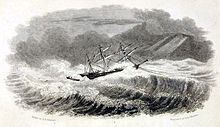Name HMS Griper Class and type Bold-class gun-brig Launched 14 July 1813 | Ordered 2 November 1812 Tons burthen 181 60/94 bm | |
 | ||
Fate Broken up November 1868 Length 84 ft 1 in (25.63 m) (overall)70 ft 0 ⁄4 in (21.342 m) (keel) | ||
HMS Griper was a Bold-class gun-brig of the British Royal Navy, built in 1813 by Mark Williams and John Davidson at Hythe. She participated in the 1819 expedition to the Arctic led by William Parry, made a voyage to Greenland and Norway in 1823, and took part in Parry's third expedition in 1824 as a support ship. Her crew in 1819, 1823, or 1824, qualified for the "Arctic Medal", which the Admiralty issued in 1857. She was eventually broken up in 1868.
Contents
Early career
Griper was commissioned in July 1813 under Commander Charles Mitchell. In February 1814 Commander Arthur M'Meekan replaced Mitchell. In 1817, Griper was at Chatham. She then underwent fitting as an exploration ship at Portsmouth between December 1818 and May 1819.
Expedition to Northwest Passage (1819)
Lieutenant Matthew Liddon recommissioned Griper in January 1819. She then sailed with William Edward Parry from London on 11 May 1819. Parry commanded two 3-masted sailing ships: the 375 ton HMS Hecla and the 182 ton Griper. Their destination was the Northwest Passage.
Griper was by far the inferior of the two ships, being described as "one of these paltry Gunbrigs.....utterly unfit for this service!" (A.Parry; Parry of the Arctic ). Their departure had previously been delayed as the condition of the Griper was described as being "so crank as to cause apprehensions to be entertained for the safety of the officers and crew". She was so slow that she had to be towed by the Hecla part of the way across the Atlantic. However, they successfully traveled further West along the Northwest Passage than any European had previously achieved. After wintering at Melville Island they returned to London in November 1820, and Griper was paid off in December.
Voyage to Greenland and Norway (1823)
Griper was refitted at Deptford between February and May 1823. Under the command of Captain Douglas Clavering, she conducted a voyage to Greenland and Spitzbergen, conveying astronomer Edward Sabine who took observations on behalf of the Board of Longitude. A further note to this voyage occurred on an island later named Clavering Island, where, in August, the expedition made the first and only European contact with the now extinct North Greenland Inuit.
Northwest Passage expedition (1824)
Between January and June 1824, Griper was refitted for a Parry’s third Northwest Passage expedition. She was commissioned under Captain George Lyon and on 16 June 1824 she sailed for Hudson Bay, and Wager Bay in support of Hecla and Fury. She departed on 3 July 1824, and proceeded in company with the survey vessel Snap. On this occasion, she was carrying a land component of men. Griper returned to London and was paid off in December 1824.
Fate
Griper was fitted for the Coast Blockade service at Portsmouth between August and December 1825. She then joined the Coast Guard at Blackwall. She later also served at Sussex.
Griper was at Portsmouth between 1827 and 1830, and at Chichester between 1831 and 1860. She served as a target for gunnery experiments in Portsmouth in 1856, and was used to test armour plate in 1862. She was broken up in November 1868.
